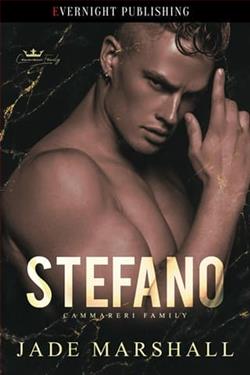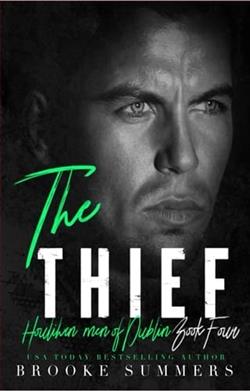Page 33 of Pieces of Ash
“No, baby doll?—”
“Tomorrow we’ll go talk to Julian,” says Jock, sliding out of the car and leaving me and Gus alone.
“We have to figure things out,” continues Gus, his low voice soothing. “Hecould find you here. Your pedophile stepmonster. If he tries to track you down, staying with me could be the worstpossible thing for you. Jock and I already talked about it on the ride to the ferry. We need to hide you.”
“But, Gus. I want to b-be withyou,” I sob. “You’re all Ih-have.”
Gus leans away from me, cupping my cheeks, his dark eyes searching mine. “Then trust me. Trust Jock. We’ll keep you safe, baby doll, I promise. But you have to trust us.”
He’s quiet, staring into my face, scanning my eyes, waiting for my reply.
And suddenly I am eight years old again, and Gus has pulled up in front of Tig’s bungalow in his shiny, blue chrome VW Bug. He is walking up the path from the sidewalk to the front door, and when he gets there, he squats down before me and says,Your mama’s in rehab, baby doll. Wanna roommate?
We’ll keep you safe, baby doll, I promise.
I have a terrible feeling that it’s not a promise Gus will be able to keep, but in a world where I’ve loved few and trusted still fewer, one unassailable truth is law as I look into the eyes of a man who’s been the truest family I’ve ever known.
“I trust you, Gus-Gus.”
He blinks back tears as he pulls me into his arms.
“Let’s get you inside,” he says with an elegant sniff. “I just bet P.C.’s got cold milk and Oreos waiting for us.”
Chapter 7
Ashley
Iwake up in Gus and Jock’s guest room, bright sunlight flooding through the white, gauzy curtains, warming my body, which is utterly inert under an eiderdown quilt. My eyes open slowly, taking in the unfussy room, the crisp white walls with several pop art reprints by Roy Lichtenstein hung at careful intervals. My eyes follow the story they tell, starting at my far left.
The first print is of a woman with a ribbon hairband in her bobbed blonde hair and a vulnerable expression on her comic book face.
In the second print, the woman’s finger is caught between her teeth in a gesture of angst, with tears about to fall from both eyes.
In the third print, her hair is royal blue, and she’s almost underwater. The bubble caption over her head reads, “I DON’T CARE! I’D RATHER SINK—THAN CALL BRAD FOR HELP!”
On the wall across from my bed are two windows, but between them is a fourth framed picture of the same woman in a convertible. She’s wearing a fur coat, facing forward, and a man—Brad?—looks at her with sinister eyes as he drives the car.
To my right are two more prints, the first is of a woman’s hand and a man’s hand, and the man is placing an engagement ring on the woman’s finger. And in the sixth and final print, the woman and man are kissing passionately.
I circle my eyes around the room again. The young woman, the tears, the drowning, the car ride, the engagement, the kiss.
In broad strokes it tells a story—first love, then conflict, and then, a happy ending.
But why does the girl’s face look so uncertain in the first print? And why is she crying in the second? She’d rather die than ask for his help in the third picture. But in the fourth, they’re back together, though his expression is ominous, like he means her harm. Then there’s a ring and a kiss. Somehow, they end up married.
What is therealstory?I wonder.Where is it? In the broad strokes or in the nuance? In the glossed-over happy ending? Or in her tears and his hostility? Where is thetruth?
A knock at the bedroom door ends my introspection, and I sit up in bed. “Come in.”
Gus peeks in, his dark skin in stark contrast to the bright white of the room. “You decent?”
I giggle. That’s the way he always woke me up when he stayed with us, and despite its inappropriateness, I love it just as much now as I did then. I pat the bed, and he sits down, crossing his legs, clad in crisp, cuffed khaki. He wears a Christian Lacroix tie as a belt and an ironed, long-sleeved Brooks Brothers button-down shirt in mint green, rolled at the cuffs. He looks like a movie director from the 1930s, cool and sophisticated, and I remember how much I’ve always admired his sense of style.
“Lacroix and Brooks Brothers?” I ask, raising an eyebrow.
“Wearein the country,” he notes with a sniff. “I could hardly break out my black leather chaps and matching rhinestone-studded vest, baby doll.”
I chuckle. “If anyone could pull them off, it’s you.”















